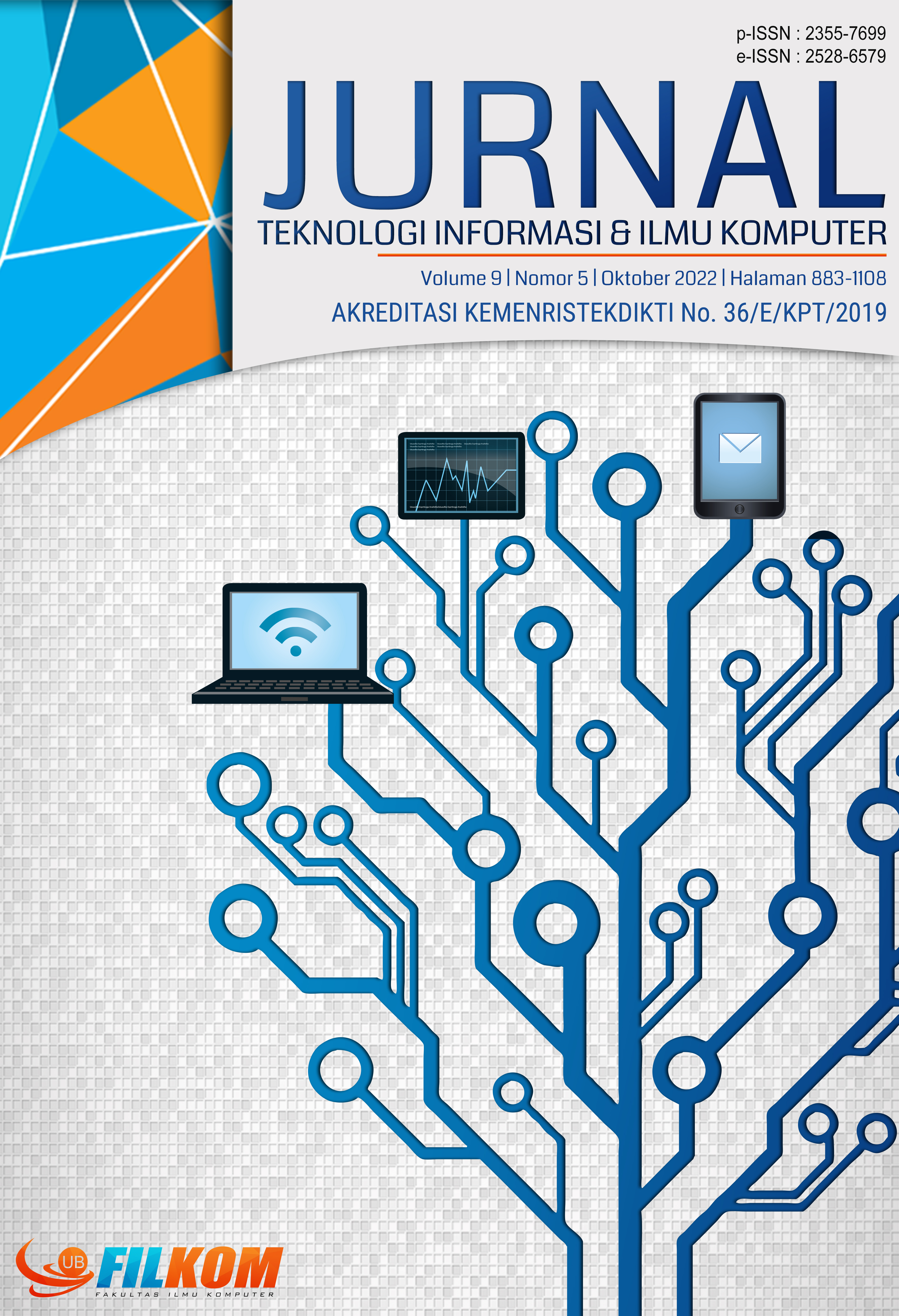Sistem Pendeteksi Banjir dan Badai Angin serta Monitoring Cuaca Berbasis Internet of Things
DOI:
https://doi.org/10.25126/jtiik.2022955983Abstrak
Curah hujan yang tinggi disertai badai angin biasanya terjadi saat musim pancaroba, hal tersebut dapat mempengaruhi aktivitas masyarakat. Perlu adanya teknologi yang dapat memberikan peringatan dini agar dapat meminimalisir dampak yang ditimbulkan, salah satunya yaitu Internet of Things yang merupakan teknologi yang memungkinkan manusia untuk mengontrol dan menjalankan tugas secara otomatis pada suatu objek yang terhubung melalui internet. Penelitian ini menciptakan sebuah prototipe alat dengan menggunakan konsep Internet of Things yang dapat memberikan peringatan dini dan monitoring ketinggian air ketika terjadi banjir, kecepatan angin, suhu, kelembaban, intensitas cahaya, dan hujan pada suatu tempat secara spesifik dan real time yang ditampilkan pada aplikasi mobile Android untuk user dan aplikasi web untuk admin. Perangkat yang digunakan yaitu seperti mikrokontroler Arduino Mega 2560, sensor ultrasonik, sensor anemometer, sensor suhu dan kelembaban, sensor intensitas cahaya, sensor hujan, buzzer, Liquid Crystal Display (LCD), modul Wi-Fi ESP8266, modul SIM800L V2, stepdown LM2596 DC-DC, modul GPS NEO-6M, baterai 18650, dan switch on off dengan 3 pin. Hasil pengujian pada prototipe alat menghasilkan pengujian yang cukup baik dan akurat yang terdiri dari pengujian keseluruhan sensor, kalibrasi setiap sensor, serta pengiriman data ke server, demikian pula pada pengujian perangkat lunak yang terdapat pada setiap fungsi aplikasi Android dan web dapat berjalan dengan optimal.
Abstract
High rainfall accompanied by windstorms usually occurs during the transition season, this can affect community activities. It is necessary to have technology that can provide early warning to minimize the impact, one of which is the Internet of Things which is a technology that allows humans to control and perform tasks automatically on an object that is connected via the internet. This research creates a prototype tool using the concept of the Internet of Things that can provide early warning and monitoring of water levels in the event of flooding, wind speed, temperature, humidity, light intensity, and rain in a specific and real time place displayed on an Android mobile application for users and web applications for admins. The devices used are Arduino Mega 2560 microcontroller, ultrasonic sensor, anemometer sensor, temperature and humidity sensor, light intensity sensor, rain sensor, buzzer, Liquid Crystal Display (LCD), ESP8266 Wi-Fi module, SIM800L V2 module, stepdown LM2596 DC-DC, NEO-6M GPS module, 18650 battery, and on off switch with 3 pins. The measurement results of the prototype tool produce a fairly good and accurate test consisting of testing the entire sensor, calibrating each sensor, and sending data to the server, as well as testing the software contained in every function of Android and web applications that can run optimally.
Downloads
Referensi
AKHIRUDDIN, 2018. Rancang Bangun Alat Pendeteksi Ketinggian Air Sungai Sebagai Peringatan Dini Banjir Berbasis Arduino Nano. Journal of Electrical Technology, Vol.3 No.(3), pp.174–179.
ARFIANTO, A.Z., GUNANTARA, N., RAHMAT, M.B., SETIYOKO, A.S., HANDOKO, C.R., HASIN, M.K., UTARI, D.A., WIDODO, H.A. AND AMINUDIN, A., 2018. Perangkat Informasi Dini Batas Wilayah Perairan Indonesia Untuk Nelayan Tradisional Berbasis Arduino Dan Modul Gps Neo-6M. Joutica, 3(2), pp.163–167.
BNPB (Badan Nasional Penanggulangan Bencana), 2021. Data Informasi Bencana Indonesia. [online] Badan Nasional Penanggulangan Bencana (BNPB). Available at: <https://dibi.bnpb.go.id/> [Accessed 21 Aug. 2021].
DIRIYANA, A., DARUSALAM, U. AND NATASHA, N.D., 2019. Water Level Monitoring and Flood Early Warning Using Microcontroller With IoT Based Ultrasonic Sensor. Jurnal Teknik Informatika C.I.T, 11(1), pp.22–28.
HAMDANI, R., PUSPITA, I.H. AND WILDAN, B.D.R.W., 2019. Pembuatan Sistem Pengamanan Kendaraan Bermotor Berbasis Radio Frequency Identification ( Rfid ). Indept, 8(2), pp.56–63.
KURNIAWAN, A.E., KASRANI, M.W. AND B, A.A., 2020. Perancangan Prototype Alat Pendeteksi Kebocoran Gas Lpg Berbasis Arduino Uno R3 Dengan Modul Sim800L Dan Esp8266 Sebagai Media Informasi. Jurnal Teknik Elektro Uniba (JTE Uniba), 4(2), pp.47–53.
PERWIRA, Y., 2019. Sistem Pendukung Keputusan Penentuan Paket Wisata Traveling pada PT. Tritura Jaya Travel Menggunakan Metode Fuzzy Tsukamoto. 3(2), pp.159–171.
PUTRA, R.D., 2015. Rancang Bangun Sistem Pemantau Cuaca (Angin) Menggunakan Mikrokontroler Arduino. pp.1–62.
RAHMAN, A. Y., & ISTIADI, I., 2020. Identifikasi Jenis Burung Lovebird Menggunakan Fitur Histogram Dengan Evaluasi Sse. In Conference on Innovation and Application of Science and Technology (CIASTECH), (Ciastech), pp.611–618.
SYAIFULLAH, S., WIJAYA, I.G.P.S. AND HUSODO, A.Y., 2018. Satisfaction Information System of Academic Administration Services Based on IPA (Importance Performance Analysis) Study Case in Faculty of Engineering, Mataram University. Journal of Computer Science and Informatics Engineering (J-Cosine), 2(1), pp.37–43.
WIBAWA, K.S. AND WIRABUANA, P., 2018. Design and Implementation of Monitoring System Automatic Water Level Reservoir Controller. International Journal of Latest Engineering Research and Applications (IJLERA), 03(12), pp.8–15.
Unduhan
Diterbitkan
Terbitan
Bagian
Lisensi

Artikel ini berlisensi Creative Common Attribution-ShareAlike 4.0 International (CC BY-SA 4.0)
Penulis yang menerbitkan di jurnal ini menyetujui ketentuan berikut:
- Penulis menyimpan hak cipta dan memberikan jurnal hak penerbitan pertama naskah secara simultan dengan lisensi di bawah Creative Common Attribution-ShareAlike 4.0 International (CC BY-SA 4.0) yang mengizinkan orang lain untuk berbagi pekerjaan dengan sebuah pernyataan kepenulisan pekerjaan dan penerbitan awal di jurnal ini.
- Penulis bisa memasukkan ke dalam penyusunan kontraktual tambahan terpisah untuk distribusi non ekslusif versi kaya terbitan jurnal (contoh: mempostingnya ke repositori institusional atau menerbitkannya dalam sebuah buku), dengan pengakuan penerbitan awalnya di jurnal ini.
- Penulis diizinkan dan didorong untuk mem-posting karya mereka online (contoh: di repositori institusional atau di website mereka) sebelum dan selama proses penyerahan, karena dapat mengarahkan ke pertukaran produktif, seperti halnya sitiran yang lebih awal dan lebih hebat dari karya yang diterbitkan. (Lihat Efek Akses Terbuka).















